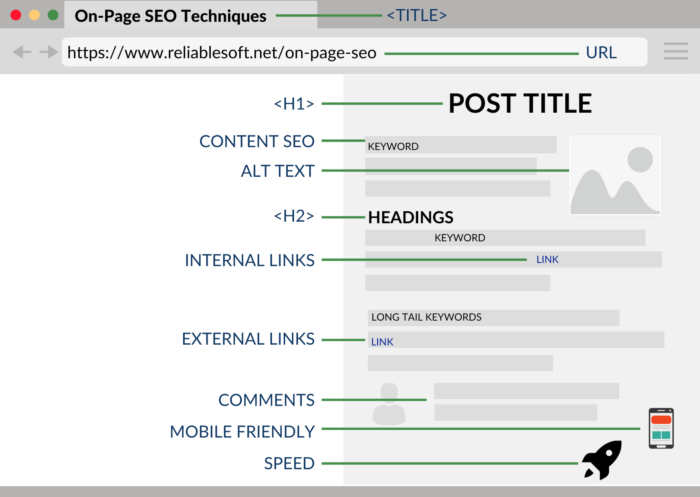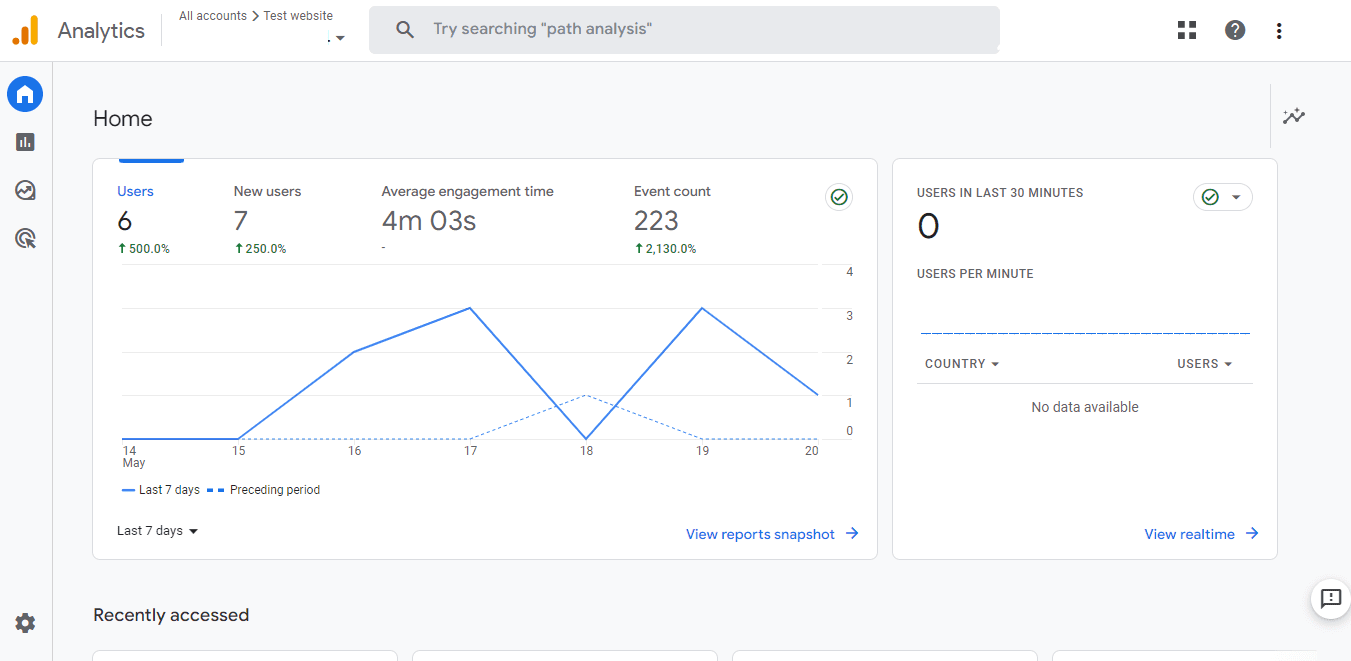In the ever-expanding digital landscape, standing out amidst the vast sea of websites has become increasingly challenging. This is where Search Engine Optimization (SEO) comes into play. SEO is the practice of optimizing websites and online content to improve their visibility and ranking in search engine results pages (SERPs). It involves a combination of technical, on-page, and off-page strategies that aim to make websites more search engine-friendly, ultimately driving organic traffic and attracting potential customers.
The importance of SEO in digital marketing cannot be overstated. With billions of searches conducted on search engines like Google, Bing, and Yahoo every day, appearing prominently in search results can significantly impact a business’s online success. By implementing effective SEO strategies, businesses can enhance their online presence, increase brand visibility, and reach their target audience at the right time and in the right place.
In the following comprehensive guide, we will delve into the fundamental aspects of SEO, equipping you with the knowledge and strategies to optimize your website and content for search engines. Whether you’re a business owner, marketer, or content creator, understanding these SEO fundamentals will empower you to navigate the competitive digital landscape and achieve long-term success in the online realm.
A. Understanding How Search Engines Work
Search engines are intricate systems that aim to provide users with relevant and valuable information in response to their search queries. Here’s a simplified breakdown of how search engines work:
- Crawling: Search engines use automated programs called “crawlers” or “spiders” to discover and browse web pages across the internet. These crawlers follow links from one page to another, building a vast index of web content.
- Indexing: Once the crawlers discover web pages, they analyze the page’s content, including text, images, and other media. The relevant information is then stored in a massive database called an index. This index allows search engines to retrieve and display relevant results quickly.
- Ranking: When a user enters a search query, the search engine retrieves relevant pages from its index and applies complex algorithms to determine the order in which the pages should appear in the search results. The ranking algorithms evaluate numerous factors like keyword relevance, quality of content, user experience, and authority of the website.
- Displaying Results: Finally, the search engine presents the most relevant and authoritative pages in the search engine results pages (SERPs). These results are typically displayed in a list format, with each page accompanied by a title, snippet, and URL.
Major Search Engines
While there are various search engines available, a few major players dominate the search engine market:
- Google: Google is the most popular search engine worldwide, holding the lion’s share of the market. Known for its advanced algorithms and constantly evolving search features, Google strives to deliver accurate and personalized search results to its users.
- Bing: Bing, operated by Microsoft, is another significant search engine. While it has a smaller market share compared to Google, Bing has unique features and provides an alternative platform for users to search the web.
- Yahoo: Yahoo, once a prominent search engine, now relies on Bing’s search results. Yahoo has shifted its focus more toward providing content, news, and email services.
- Baidu: Baidu is the dominant search engine in China, with a vast user base. Its algorithms and features cater specifically to the Chinese market.
- Yandex: Yandex is the leading search engine in Russia and offers search services in Russian and other languages. It also provides additional services like maps, email, and cloud storage.

Search Engine Algorithms and Updates
Search engines employ complex algorithms to determine the relevance and ranking of web pages. These algorithms consider a wide range of factors to provide the best search results. Here are a few key points regarding search engine algorithms and updates:
- Ranking Factors: Search engine algorithms consider numerous ranking factors, including keyword relevance, website authority, user experience, page load speed, mobile-friendliness, backlinks, and social signals. Each search engine has its unique way of weighing these factors.
- Algorithm Updates: Search engines regularly update their algorithms to improve the quality of search results and combat spammy tactics. For example, Google frequently releases major updates like Panda, Penguin, and Hummingbird, which target low-quality content, link schemes, and improve semantic search, respectively. These updates can have a significant impact on website rankings and visibility.
- User Intent: Search engines strive to understand user intent and deliver results that align with their search queries. They aim to provide the most relevant content, whether it’s informational, transactional, or navigational in nature.
- Personalization: Search engines personalize search results based on various factors like user search history, location, and preferences. This personalization enhances the search experience by delivering more targeted and tailored results
Staying updated with search engine algorithms and updates is crucial for SEO practitioners and website owners. It helps ensure that their websites align with the latest guidelines and best practices, ultimately improving their chances of ranking well in search results.
Understanding how search engines work, knowing the major search engines, and keeping up with algorithm updates are fundamental aspects of SEO. By having this knowledge, you can optimize your website and content to better align with search engines’ requirements and enhance your visibility in the competitive online landscape.
B. Keyword Research
Keyword research is a vital aspect of any successful SEO strategy. It involves identifying and analyzing the specific words and phrases that users enter into search engines when looking for information, products, or services. Here are some key reasons why keyword research is important:
- Understanding User Intent: Keyword research helps you gain insights into what your target audience is searching for and the specific language they use. By understanding user intent, you can create content that directly addresses their needs, increasing the chances of attracting relevant organic traffic.
- Driving Relevant Traffic: By targeting the right keywords, you can attract users who are actively searching for what your website offers. This increases the likelihood of driving highly targeted and relevant traffic, which can lead to higher conversion rates and better user engagement.
- Content Optimization: Keyword research helps you optimize your website’s content by strategically incorporating relevant keywords. This optimization signals to search engines that your content is valuable and relevant to users, potentially leading to higher rankings in search results.
- Discovering New Opportunities: Keyword research can uncover new keyword opportunities and niche markets that you may not have considered. By identifying untapped keywords or long-tail variations, you can target specific segments of your audience and gain a competitive advantage.

Tools for Keyword Research
To conduct effective keyword research, several tools can assist you in finding relevant keywords, analyzing search volume, and understanding keyword competition. Here are some popular tools:
- Google Keyword Planner: This free tool from Google Ads provides valuable insights into search volumes, keyword ideas, and competition. It’s a great starting point for keyword research and can help you identify high-volume keywords for your niche.
- SEMrush: SEMrush is a comprehensive SEO tool that offers robust keyword research capabilities. It provides keyword suggestions, search volume data, competitive analysis, and even helps identify related keywords.
- Moz Keyword Explorer: Moz Keyword Explorer provides in-depth keyword research data, including search volume, difficulty score, organic click-through rates, and keyword suggestions. It also offers competitive analysis features to help you uncover new keyword opportunities.
- Ahrefs Keywords Explorer: Ahrefs is a powerful SEO tool that offers a variety of features, including a comprehensive keyword research tool. It provides accurate search volume data, keyword difficulty scores, and a range of keyword suggestions.
Types of Keywords
Understanding the different types of keywords is crucial for effective keyword research and content optimization. Here are the main types of keywords you should consider:
- Short-Tail Keywords: Short-tail keywords are broad and usually consist of one or two words. They have high search volumes but tend to be highly competitive. Examples include “digital marketing” or “SEO tips.”
- Long-Tail Keywords: Long-tail keywords are more specific and typically contain three or more words. They have lower search volumes but often exhibit higher conversion rates and less competition. Examples include “best SEO strategies for e-commerce” or “affordable digital marketing services in New York.”
- LSI Keywords: LSI (Latent Semantic Indexing) keywords are terms related to your primary keyword. Search engines use LSI to understand the context and relevance of content. Including LSI keywords in your content helps search engines grasp the topic better. For example, if your primary keyword is “SEO,” LSI keywords could be “search engine optimization,” “website ranking,” or “keyword research.”
Competitor Analysis and Keyword Selection
Analyzing your competitors’ keyword strategies can provide valuable insights and help you make informed decisions during keyword selection. Here’s how to conduct competitor analysis for keyword research:
- Identify Competitors: Start by identifying your main competitors in the online space. These are websites or businesses targeting a similar audience or offering similar products/services.
- Analyze Competitor Keywords: Use keyword research tools to identify the keywords your competitors are targeting. Look for keywords with high search volume, low competition, and relevance to your business.
- Assess Competitor Rankings: Determine which keywords your competitors are ranking well for in search results. Analyze their content and page optimization strategies for those keywords to gain insights and identify areas for improvement.
- Identify Gaps and Opportunities: Look for keywords that your competitors are not targeting or keywords where they have lower rankings. These gaps can present opportunities for you to focus on and gain an advantage in organic search results.
- Refine Your Keyword Selection: Based on your competitor analysis, refine your list of target keywords. Choose a mix of high-volume, competitive keywords, as well as long-tail and LSI keywords that offer better opportunities for ranking and attracting targeted traffic.
By conducting thorough keyword research and competitor analysis, you can develop a comprehensive keyword strategy that aligns with your business goals, optimizes your content, and improves your visibility in search engine results. Keyword research forms the foundation of a successful SEO strategy. It helps you understand user intent, drive relevant traffic, optimize your content, and discover new opportunities. Utilizing the right keyword research tools and considering different types of keywords, along with competitor analysis, will enable you to select the most effective keywords for your website and improve your chances of ranking well in search engine results.
C. On-Page Optimization
Effective on-page optimization involves carefully optimizing elements like title tags, meta descriptions, header tags, URL structure, keyword placement and density, image optimization, alt tags, internal linking, and site navigation. By implementing these strategies, you can improve your website’s visibility, user experience, and search engine rankings, ultimately driving more organic traffic and achieving better results in the search engine results pages (SERPs).

Title Tags, Meta Descriptions, and Header Tags
- Title Tags: Title tags are HTML elements that define the title of a webpage. They appear as clickable headlines in search engine results and should accurately describe the content of the page. It’s important to include relevant keywords in your title tags while keeping them concise and compelling.
- Meta Descriptions: Meta descriptions provide a brief summary of a webpage’s content. Although they don’t directly impact rankings, well-crafted meta descriptions can influence click-through rates. Include relevant keywords and create compelling meta descriptions that entice users to click on your link.
- Header Tags: Header tags (H1, H2, H3, etc.) structure your content hierarchically. They help search engines understand the organization and importance of your content. Use header tags to highlight important sections and incorporate relevant keywords in a natural and user-friendly manner.
URL Structure and Permalinks
- URL Structure: A well-structured URL should be descriptive, concise, and readable. Include relevant keywords in the URL to provide both search engines and users with an understanding of the page’s content. Use hyphens to separate words for clarity.
- Permalinks: Permalinks are the permanent URLs that point to your web pages. Ensure that your permalinks are concise, keyword-rich, and reflect the content of the page. Avoid using numbers or vague identifiers and strive for URLs that are user-friendly and easy to share.
Keyword Placement and Density
- Keyword Placement: Incorporate your target keywords naturally throughout your content, including in the page’s title, headings, subheadings, and body text. Place keywords strategically but avoid keyword stuffing, as it can negatively impact user experience and search engine rankings.
- Keyword Density: Keyword density refers to the percentage of times a keyword appears compared to the total word count on a page. While there’s no specific ideal keyword density, aim for a balanced and natural distribution of keywords. Focus on creating high-quality, valuable content that satisfies user intent rather than obsessing over keyword density.
Image Optimization and Alt Tags
- Image Optimization: Optimize your images to improve page load speed and enhance user experience. Compress images to reduce file size without compromising quality. Use the appropriate file format (JPEG, PNG, etc.) and ensure images are properly scaled for optimal display.
- Alt Tags: Alt tags, or alternative text, provide a description of an image for users who are visually impaired or when the image cannot be displayed. Include relevant keywords in alt tags where appropriate, but ensure they accurately describe the image’s content.
Internal Linking and Site Navigation
- Internal Linking: Internal links connect different pages within your website. They help search engines discover and index your content, establish information hierarchy, and improve user navigation. Incorporate relevant anchor text when linking between pages, using keywords when appropriate.
- Site Navigation: A well-structured site navigation enhances user experience and search engine crawlability. Ensure your website has a clear and intuitive navigation menu that allows users to easily find and access different sections of your site. Use descriptive labels and organize your menu logically.
D. Technical SEO
By implementing technical SEO practices such as site speed optimization, mobile optimization, XML sitemaps, robots.txt files, canonical URLs, and structured data, you can enhance the performance and visibility of your website. These technical optimizations contribute to better user experience, improved search engine rankings, and increased organic traffic.

Site Speed and Performance Optimization
- Importance of Site Speed: Site speed is crucial for user experience and search engine rankings. Slow-loading websites can lead to higher bounce rates, lower user engagement, and decreased conversion rates. Optimizing site speed improves user satisfaction and search engine visibility.
- Performance Optimization Techniques: Implement various techniques to improve site speed, such as optimizing images by compressing them without compromising quality, enabling browser caching, minifying CSS and JavaScript files, reducing server response time, and using content delivery networks (CDNs) to deliver content more efficiently.
- Page Load Time: Aim for fast page load times to enhance user experience. Optimize your HTML, CSS, and JavaScript code, reduce the number of HTTP requests, and leverage browser caching to speed up page rendering.
Mobile Optimization and Responsive Design
- Mobile Optimization: With the rise of mobile usage, it’s essential to optimize your website for mobile devices. Ensure your website is responsive, meaning it adapts and displays properly on different screen sizes. Implement mobile-friendly design practices, such as using mobile-compatible fonts, optimizing touch elements, and ensuring fast loading times on mobile devices.
- Responsive Design: Responsive design allows your website to adjust its layout and content dynamically based on the user’s screen size. This approach eliminates the need for separate mobile and desktop versions of your site, providing a consistent user experience across devices and improving mobile search rankings.
XML Sitemaps and Robots.txt Files
- XML Sitemaps: XML sitemaps help search engines understand the structure and organization of your website. Create and submit an XML sitemap to search engines to ensure all your webpages are indexed. Include important metadata, such as the last modified date and the priority of each page, to provide search engines with relevant information.
- Robots.txt Files: The robots.txt file tells search engine crawlers which pages or directories to crawl and which to exclude. Use this file to block search engines from indexing sensitive or duplicate content, such as login pages or print versions of pages. Be cautious when using robots.txt to avoid accidentally blocking essential pages from indexing.
Canonical URLs and Duplicate Content
- Canonical URLs: Canonical URLs indicate the preferred version of a webpage when multiple versions with similar content exist. Use canonical tags to consolidate duplicate or similar content under a single preferred URL, reducing the risk of duplicate content issues and consolidating ranking signals for search engines.
- Duplicate Content: Duplicate content can harm your search engine rankings. Avoid duplicating content within your website and across different domains. When creating content, focus on providing unique and valuable information to users.
Schema Markup and Structured Data
- Schema Markup: Schema markup is a structured data vocabulary that helps search engines understand the context of your content. Implementing schema markup allows search engines to display rich snippets in search results, enhancing your visibility and providing users with more information. Use schema markup to highlight key information such as reviews, ratings, business details, events, and products.
- Structured Data: Structured data is a standardized format that organizes and labels data on your website. It provides additional context to search engines and can improve your chances of appearing in special search result features like knowledge panels, carousels, and featured snippets. Implement structured data to provide more detailed information about your content and improve its visibility.
E. Off-Page Optimization
Link building is a crucial aspect of off-page optimization. It involves acquiring high-quality, relevant backlinks from other websites to improve your website’s authority and search engine rankings. Here are some effective link-building strategies:

- Content Creation: Create high-quality, valuable content that naturally attracts links from other websites. This can include informative articles, infographics, videos, or industry reports.
- Outreach and Guest Posting: Reach out to relevant websites and offer to write guest posts. Guest blogging allows you to showcase your expertise, gain exposure to new audiences, and earn backlinks to your website.
- Broken Link Building: Identify broken links on reputable websites and offer relevant alternative content from your website. This approach helps website owners fix broken links while gaining new backlinks for their sites.
- Influencer Collaboration: Collaborate with influencers or industry experts who have a strong online presence. Their endorsement and mention of your website can lead to valuable backlinks and increased visibility.
Best Practices for Link Building
- Focus on Quality over Quantity: Aim for high-quality backlinks from authoritative and relevant websites. A few high-quality backlinks are more valuable than many low-quality ones.
- Natural Link Profile: Build a diverse and natural link profile by acquiring links from various sources such as blogs, news sites, industry directories, and social media platforms.
- Avoid Black Hat Techniques: Stay away from unethical practices like buying links or participating in link schemes. These tactics can lead to penalties and damage your website’s reputation.
Guest Blogging and Content Promotion
- Guest Blogging: Guest blogging involves writing and publishing articles on other websites in your industry. It helps you build relationships, establish authority, and earn backlinks. When guest blogging, ensure that the websites are reputable, relevant, and have an engaged audience.
- Content Promotion: After publishing content on your own website, promote it across various channels to increase its visibility and reach. Share your content on social media, participate in industry forums, and reach out to influencers or relevant communities to attract more traffic and potential backlinks.
Social Media Signals and Engagement
- Social Media Signals: Search engines consider social media signals as a factor in determining a website’s authority and relevance. Engage with your audience on social media platforms, share your content, and encourage social sharing. This can lead to increased visibility, traffic, and potential backlinks.
- Community Engagement: Participate in relevant online communities and industry forums. Contribute valuable insights, answer questions, and engage in discussions. This helps you build relationships, establish your expertise, and gain exposure to potential link opportunities.
Online Directories and Citations
- Online Directories: Submitting your website to reputable online directories can help improve your website’s visibility and provide valuable backlinks. Look for directories specific to your industry or location and ensure they have a good reputation.
- Citations: Citations refer to mentions of your business name, address, and phone number (NAP) on other websites, even if they don’t link back to your site. Citations help establish your online presence and can positively impact local search engine rankings.
Influencer Outreach and Partnership
- Influencer Outreach: Identify influential individuals or thought leaders in your industry and reach out to them. Establish relationships and explore opportunities for collaboration, such as guest blogging, co-creating content, or participating in joint events. Their endorsement and promotion can drive traffic, increase brand visibility, and attract backlinks.
- Partnership Opportunities: Seek partnerships with complementary businesses or organizations. Collaborate on projects, sponsor events, or exchange guest posts. These partnerships can expand your reach, attract new audiences, and lead to valuable backlinks.
Off-page optimization plays a significant role in improving your website’s authority, visibility, and search engine rankings. By implementing effective link-building strategies, leveraging guest blogging and content promotion, engaging on social media, utilizing online directories and citations, and building relationships through influencer outreach and partnerships, you can enhance your off-page optimization efforts and drive more organic traffic to your website.
F. Content Marketing and SEO
Content marketing and SEO go hand in hand. By creating high-quality, relevant content, incorporating keywords naturally, optimizing your blog posts and articles, and actively promoting your content while implementing effective link-building strategies, you can enhance your search engine visibility, attract organic traffic, and establish your website as a valuable resource within your industry.

Creating High-Quality, Relevant Content
- Understand Your Target Audience: To create high-quality content, it’s crucial to understand your target audience. Conduct thorough research to identify their needs, interests, and pain points. This understanding will guide your content creation process.
- Provide Value and Unique Insights: Focus on providing valuable and unique content that addresses your audience’s needs. Offer insights, solutions, and actionable advice that differentiate your content from competitors.
- Use Different Content Formats: Experiment with different content formats such as articles, blog posts, videos, infographics, podcasts, and interactive content. This variety keeps your audience engaged and caters to different preferences.
- Consistency and Frequency: Maintain a consistent content publishing schedule to keep your audience engaged and demonstrate your reliability. However, prioritize quality over quantity. It’s better to publish less frequently with high-quality content than to sacrifice quality for quantity.
Incorporating Keywords Naturally
- Keyword Research: Conduct keyword research to identify relevant keywords and phrases that align with your content and target audience’s search intent. Use tools like Google Keyword Planner, SEMrush, or Moz Keyword Explorer to find valuable keywords.
- Strategic Keyword Placement: Incorporate keywords naturally within your content. Place them in your title tag, headings, subheadings, introductory and concluding paragraphs, and throughout the body of your content. Avoid keyword stuffing, as it can negatively impact user experience and search engine rankings.
- Latent Semantic Indexing (LSI) Keywords: Include LSI keywords, which are conceptually related to your target keywords, to provide search engines with a better understanding of your content’s context. LSI keywords also help you rank for variations of your target keywords.
Optimizing Blog Posts and Articles
- Title Tags and Meta Descriptions: Craft compelling and keyword-rich title tags and meta descriptions that accurately represent your content and entice users to click. Keep them concise, within the recommended character limits, and optimized for search engines.
- Heading Tags (H1, H2, H3): Use header tags to structure your content and guide readers through your article. Include your target keywords naturally in heading tags to provide clarity and context.
- URL Structure: Create search engine-friendly URLs that include relevant keywords and accurately describe your content. Use hyphens to separate words and keep URLs concise and readable.
- Internal Linking: Incorporate internal links within your blog posts and articles to guide readers to related content on your website. This helps search engines understand the structure of your website and improves user navigation.
- Readability and Formatting: Ensure your content is easy to read and well-formatted. Use short paragraphs, subheadings, bullet points, and bold/italic text to break up the content and make it scannable for readers.
Content Promotion and Link Building
- Content Promotion: Actively promote your content through various channels. Share it on social media platforms, reach out to your email subscribers, engage in online communities, and participate in industry forums. Encourage social sharing and engagement to increase visibility and attract backlinks.
- Guest Blogging and Influencer Outreach: Write guest posts for reputable websites in your industry. This not only allows you to showcase your expertise but also provides an opportunity to earn backlinks to your website. Collaborate with influencers or industry experts to co-create content, tap into their audience, and gain valuable backlinks.
- Link Building: Develop a link-building strategy to acquire high-quality backlinks from authoritative websites. This can include outreach, broken link building, resource link building, and leveraging relationships with partners or industry associations. Focus on building relationships and providing value to increase your chances of earning backlinks.
G. Local SEO
Local SEO is essential for businesses looking to attract customers in specific geographic locations. By optimizing your Google My Business listing, submitting to relevant local directories, and actively managing online reviews and reputation, you can enhance your local search visibility, establish trust with customers, and drive more local traffic to your business.

Importance of Local SEO for Businesses
- Targeting Local Customers: Local SEO is crucial for businesses that operate in specific geographic locations. It helps you target potential customers in your area who are actively searching for local products or services.
- Increased Online Visibility: Local SEO techniques improve your online visibility within local search results. This can lead to higher rankings in local search engine results pages (SERPs), increased website traffic, and more foot traffic to your physical location.
- Enhanced Competitiveness: Optimizing for local search allows small and medium-sized businesses to compete effectively against larger corporations. Local SEO levels the playing field, as it focuses on relevance and proximity to users’ location rather than just overall website authority.
Optimizing Google My Business Listing
- Claim and Verify Your Listing: Start by claiming and verifying your Google My Business (GMB) listing. Provide accurate and up-to-date information about your business, including name, address, phone number (NAP), website URL, business hours, and categories.
- Complete Your Profile: Fill out all relevant sections of your GMB profile, including business description, services, products, photos, and videos. Add a compelling business introduction and highlight unique selling points.
- Customer Reviews and Ratings: Encourage customers to leave reviews on your GMB listing. Respond promptly to both positive and negative reviews to show that you value customer feedback. Positive reviews and high ratings can boost your local search visibility.
- Local Posts and Updates: Utilize the “Posts” feature in your GMB listing to share updates, offers, events, and announcements. This helps engage with your audience and keep them informed about your business.
Local Directory Submissions
- NAP Consistency: Ensure consistent and accurate NAP information (name, address, phone number) across all online directories and local citations. Inconsistent information can confuse search engines and potential customers, negatively impacting your local SEO efforts.
- Relevant Directories: Submit your business to relevant local directories, industry-specific directories, and review websites. Focus on authoritative and trustworthy directories that are relevant to your business’s location and industry.
- Optimized Business Descriptions: Craft compelling business descriptions that incorporate relevant keywords and accurately represent your products or services. This helps search engines understand your business and improves your chances of appearing in local search results.
Online Reviews and Reputation Management
- Encourage Reviews: Actively encourage customers to leave reviews on platforms such as Google, Yelp, and industry-specific review websites. Positive reviews help build trust, attract new customers, and improve your local search visibility.
- Respond to Reviews: Monitor and respond to customer reviews promptly and professionally. Express gratitude for positive reviews and address any negative feedback with a helpful and empathetic approach. This demonstrates your commitment to customer satisfaction and reputation management.
- Online Reputation Monitoring: Regularly monitor online mentions of your business to stay aware of customer feedback, reviews, and discussions. Utilize online reputation management tools to track your reputation, respond to feedback, and address any potential issues promptly.
H. SEO Analytics and Reporting
SEO analytics and reporting are essential for understanding the performance and impact of your SEO efforts. By setting up Google Analytics, tracking key metrics, conducting regular SEO analysis, and utilizing tools like Google Search Console, Moz, and SEMrush, you can gain valuable insights, measure ROI, and make data-driven decisions to optimize your website’s SEO performance.
Setting up Google Analytics
- Create a Google Analytics Account: Sign up for a Google Analytics account by visiting the Google Analytics website. Follow the prompts to create an account, set up your property (website), and generate a tracking code.
- Install Tracking Code: Insert the generated tracking code into the HTML of your website. Place it just before the closing </head> tag to ensure it loads on all pages. This tracking code allows Google Analytics to collect data about your website visitors.
- Configure Goals and Conversion Tracking: Set up goals within Google Analytics to track specific actions on your website, such as form submissions, purchases, or newsletter sign-ups. This helps measure the effectiveness of your SEO efforts in driving conversions.
Tracking Key Metrics
- Organic Traffic: Monitor the amount of traffic coming to your website from organic search. Analyze the number of sessions, users, pageviews, and average session duration. Track the trend over time to evaluate the impact of your SEO strategies.
- Conversions: Measure the number of conversions generated through organic search. This could include form submissions, purchases, or any other desired actions on your website. Set up goals in Google Analytics to track conversions and evaluate the effectiveness of your SEO campaigns.
- Bounce Rate: Assess the bounce rate, which indicates the percentage of visitors who leave your website after viewing only one page. A high bounce rate may indicate issues with page relevance, user experience, or targeting. Aim to optimize pages with high bounce rates to improve engagement.
- Click-Through Rate (CTR): Analyze the CTR of your website’s organic search listings in search engine results pages (SERPs). A higher CTR indicates that your page’s title tag and meta description are compelling and relevant to users’ search queries. Optimize meta tags to increase CTR.
- Keyword Rankings: Track the rankings of your target keywords in search engine results. Monitor the progress of your keyword optimization efforts and identify opportunities for improvement. Use tools like Google Search Console, Moz, or SEMrush to track keyword rankings.
SEO Reporting and Analysis
- Monthly Performance Reports: Generate monthly reports that highlight key SEO metrics and trends. Include data on organic traffic, conversions, keyword rankings, and other relevant metrics. Provide insights and recommendations for further improvement.
- Traffic Sources Analysis: Analyze the sources of your website traffic, including organic search, direct visits, referrals, and social media. Identify which sources drive the most valuable traffic and focus your SEO efforts accordingly.
- Landing Page Performance: Evaluate the performance of individual landing pages. Analyze metrics such as page views, bounce rate, time on page, and conversions. Identify high-performing pages and optimize underperforming ones.
- User Behavior Analysis: Explore user behavior metrics like session duration, pages per session, and exit pages. Gain insights into user engagement, popular content, and potential areas for improvement in user experience.
- SEO ROI Analysis: Measure the return on investment (ROI) of your SEO efforts by comparing the value of organic traffic and conversions against the resources invested in SEO activities. Assess the impact of SEO on overall business goals and revenue.
Tools for SEO Analytics
- Google Search Console: Use Google Search Console to monitor website performance in search results. Gain insights into keywords, impressions, clicks, and crawl errors. Identify indexing issues, submit sitemaps, and review mobile usability.
- Moz: Moz offers a suite of SEO tools, including keyword research, site audits, rank tracking, and backlink analysis. Utilize Moz to track keyword rankings, analyze site health, and discover opportunities for optimization.
- SEMrush: SEMrush provides comprehensive SEO analytics and competitor research. Conduct keyword research, track rankings, analyze backlinks, and monitor social media performance. Use SEMrush to gain competitive insights and improve your SEO strategy.
- Google Analytics: In addition to tracking website traffic, Google Analytics offers valuable SEO insights. Analyze organic search data, monitor user behavior and track conversions. Set up custom reports and dashboards to focus on SEO-specific metrics.
I. SEO Best Practices and Future Trends
By staying up to date with algorithm changes, focusing on user experience, optimizing for voice search and mobile-first indexing, and understanding the role of AI in SEO, you can stay ahead of the curve and ensure your SEO strategies align with future trends. Continuously adapt and optimize your website to provide the best possible user experience while catering to evolving search engine algorithms.
Staying Up to Date with Algorithm Changes
- Continuous Learning: SEO best practices are constantly evolving due to algorithm updates by search engines like Google. Stay updated by following reputable SEO blogs, attending industry conferences, and participating in online communities to stay informed about the latest trends and algorithm changes.
- Google Webmaster Guidelines: Familiarize yourself with Google’s Webmaster Guidelines, as they provide insights into the search engine’s expectations and best practices. Adhering to these guidelines can help maintain a strong SEO foundation.
- Core Algorithm Updates: Monitor major algorithm updates such as Google’s Core Updates. Understand their impact on search rankings and user experience. Adjust your SEO strategies and tactics accordingly to adapt to any changes.
User Experience (UX) and SEO
- Page Speed: Optimize your website’s loading speed to enhance user experience. Compress images, enable browser caching, and minify code to reduce page load times. A fast-loading website improves user satisfaction and can positively impact search rankings.
- Mobile-Friendly Design: Ensure your website is mobile-friendly and responsive across various devices. Mobile usability is a significant ranking factor, as more users are accessing the internet via smartphones and tablets. Use responsive design and optimize for mobile to provide a seamless user experience.
- Clear Site Structure and Navigation: Organize your website’s content with a clear and intuitive structure. Implement logical navigation menus and internal linking to help users find relevant information easily. A well-structured website enhances user experience and improves search engine crawlability.
- Engaging and Relevant Content: Create high-quality, relevant content that meets the needs of your target audience. Focus on providing value, addressing user queries, and offering engaging and informative content. This helps improve user engagement metrics and encourages repeat visits.
Voice Search and Mobile-First Indexing

- Voice Search Optimization: Optimize your website for voice search by incorporating natural language and conversational keywords. Voice search queries tend to be longer and more conversational compared to text-based searches. Optimize content to answer specific questions and provide concise, helpful answers.
- Mobile-First Indexing: With mobile-first indexing, search engines prioritize the mobile version of your website when determining search rankings. Ensure your website is mobile-friendly, loads quickly on mobile devices, and provides a seamless user experience across all screen sizes.
- Structured Data and Schema Markup: Implement structured data and schema markup on your website to provide search engines with additional context about your content. This can enhance search engine visibility and improve the chances of appearing in featured snippets or voice search results.
Artificial Intelligence (AI) in SEO
- RankBrain and Machine Learning: Google’s RankBrain, a machine learning algorithm, plays a significant role in search rankings. Understand the basics of machine learning and how RankBrain interprets user intent. Optimize content to align with user intent and provide relevant solutions.
- Natural Language Processing (NLP): NLP allows search engines to better understand and interpret user queries. Create content that aligns with the semantic meaning of user queries and provides comprehensive answers. Focus on context and intent rather than just specific keywords.
- Personalization and User Behavior: AI-driven algorithms consider user behavior signals to personalize search results. Aim to create personalized user experiences by offering tailored recommendations, personalized content, and relevant suggestions based on user preferences and past interactions.
- AI-Powered Tools: Leverage AI-powered SEO tools that analyze large data sets, identify patterns, and provide actionable insights. These tools can help with keyword research, content optimization, competitor analysis, and predictive analytics.
Final Takeaway: Understanding the Basics of SEO
Understanding and implementing SEO strategies is crucial for online success. By following the key points outlined in this comprehensive guide, you can improve your website’s visibility, attract more organic traffic, and ultimately achieve your business goals.
Now, it’s time to take action and implement these SEO strategies to improve your online presence. Remember, SEO is an ongoing process that requires monitoring, analyzing, and adapting to changes. Embrace the opportunities presented by SEO and make it an integral part of your digital marketing strategy.
For further learning, here are some resources you can explore:
- Moz: A comprehensive SEO resource offering guides, articles, tools, and industry insights.
- Search Engine Land: A reputable source for SEO news, tips, and best practices.
- Google Webmaster Central Blog: Official blog by Google, providing insights into search algorithms and updates.
- SEMrush Academy: Offers free online courses on SEO, digital marketing, and using SEMrush tools.
- HubSpot Academy: Provides various free courses on inbound marketing, including SEO fundamentals.
Remember, SEO is a dynamic field, so continuous learning and staying informed about the latest trends and strategies will help you stay ahead. Implementing effective SEO practices can significantly impact your online visibility, user engagement, and business success. Start your SEO journey today and unlock the potential of organic search traffic.


